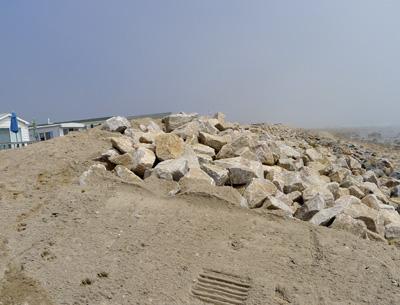State Investigating Rock Wall at Montauk Shores

A rock revetment built in April on the east side of the Ditch Plain beach in front of the Montauk Shores Condominiums, an oceanfront mobile home park, is under investigation by the New York State Department of Environmental Conservation.
State officials visited the site last week, and it is now part of an ongoing investigation, said Bill Fonda, a D.E.C. spokesman.
The revetment is blocking access by beachcombers and to a popular fishing site called Cavett’s Cove. The Concerned Citizens of Montauk and the East Hampton-Long Island Chapter of the Surfrider Foundation have filed complaints with the D.E.C.
A permit issued to Montauk Shores on Nov. 27, 2012, by Tom Preiato, East Hampton Town’s senior building inspector, states that approval was granted for work to “restore storm-damaged dune with sand and relocation of existing rocks at the existing manufactured home park.”
But environmentalists say the scope of the project, which is being done by the Keith Grimes company, exceeds what is allowed under the permit. Jeremy Samuelson, executive director of the Concerned Citizens, said yesterday that it was obvious that existing rocks were not used.
At a meeting earlier this month of the town board-appointed Montauk Citizens Advisory Committee, Ray Cortell, a committee member, said he saw rocks being delivered by truck at 10 p.m. one night in April. “It was all very innocuous,” he said.
Tom Muse, a Montauk resident and an environmental consultant for the Surfrider Foundation, said the revetment was a “hot topic on the beach.”
He said the rocks used in April were significantly larger than allowed by the D.E.C. permit, which called for the use of locally quarried stone. “All this matters very much for people who use that beach,” Mr. Muse said. He explained that the revetment dramatically changes the natural beach dynamic, as Long Island beaches are fed sand from beaches and cliffs to the east of them. “The trailer park sea wall does not, so to speak, play along,” he said.
That the expanded revetment will cause sand to move offshore for some distance due to the wave energy coming off it, is a fairly well understood coastal phenomenon and “probably why the D.E.C. said they would provide the permit for the rocks if the mobile park officials agreed to keep it capped with sand,” Mr. Muse said. “To my knowledge, they have never kept up their end of the bargain.”
Mr. Samuelson said that public access to the site would only be possible at the lowest of tides. “But the real concern is that shore-hardening structures beget shore-hardening structures,” he said — the more you build, the more sand you are going to lose.
“The real tragedy here is that we’ve failed to require additional review of a project like this. The town has failed to insist over the last decade that this be reviewed by an adequate engineer,” Mr. Samuelson concluded.
Phone calls to Montauk Shores Condominium representatives were not returned.
